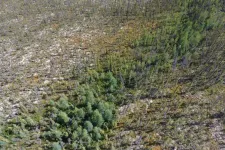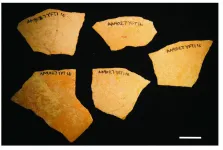(Press-News.org) Older adults were significantly affected by isolation and stress during Oregon's initial COVID-19 lockdown last spring, but they were also able to find connection and meaning in community, new hobbies and time for themselves, a recent Oregon State University study found.
If resilience is understood as the ability to see positives in the midst of a negative situation, then many of the study's participants demonstrated resilience during that time, the researchers said.
"A lot of times we think about resilience as a personality trait, and it's true that there are some qualities that may help people experience that. But in the end, resilience is something that is shared," said Heidi Igarashi, first author on the study and a recent doctoral graduate of OSU's College of Public Health and Human Sciences. "One of the things that came out in our study was the degree to which the people-connection was really significant."
The study, published in the Journals of Gerontology: Psychological Sciences, surveyed 235 adults ages 51 to 95 about their experiences from April 28-May 4, 2020, when Oregon's statewide stay-at-home order had been in place for about a month.
The online survey asked participants about recent and ongoing difficulties in their lives caused by COVID-19, as well as recent positive experiences.
People shared experiences at the personal, interpersonal and societal levels. Personal difficulties included the stress of constant vigilance around ensuring safety in everyday activities, as well as fear of death and uncertainty about the future. Interpersonal challenges included social isolation, lack of physical contact and fear for loved ones' health. Societal stressors were centered on lack of scientific leadership and concerns for the community at large.
While 94% of participants listed difficulties, roughly 63% shared positive experiences. At the personal level, these included things like trying new projects -- gardening, cooking -- and increased gratitude for the simpler, slower pace of life. Interpersonal joys were found in new friendships or reconnecting with old friends, and in people caring for one another. At the societal level, some noted the benefit to the environment from people driving less and the sense of increased community solidarity.
Older adults took comfort in seeing neighbors and friends taking care of each other, while simultaneously adding to community resilience by looking after friends and neighbors themselves and joining group efforts like mask-sewing drives, said co-author Carolyn Aldwin, the Jo Anne Leonard Endowed Director of the Center for Healthy Aging Research at OSU.
"It's a mistake to think of older adults as just being sort of victims during COVID," Aldwin said. "They're a lot more resilient than we think they are, and they're important for the community."
Many of the survey respondents engaged in Zoom calls with family and friends, enjoyed time spent in nature and finally finished projects that had been sitting in the closet or garage.
Retired folks had a harder time than those who are employed because the lockdown was more disruptive to their routine, including closing off regular volunteer opportunities because of older adults' high-risk status. But some respondents reported feeling relief at being able to focus on themselves for a change, with pursuits like meditation and journaling, rather than spending all their time caring for other people.
The study was conducted via internet survey, which affected response rates; the majority of participants were white, female, retired and highly educated, as opposed to the racial, ethnic and socioeconomic groups that have been hardest hit by COVID-19 infections and death, the researchers said.
But Aldwin cautions against assumptions about resilience among less-advantaged groups. While they may have experienced more loss and financial distress, a key factor in resilience is being able to find purpose in life, which can occur through helping others.
"There's this meaning that's found in caregiving, a reason for living, where our study group often didn't have these demands on them, and they were feeling a lack of sense of meaning," she said. "If you're the person who's holding the family together during this crisis, that's a source of meaning. Clearly we would have seen more loss and more difficulty, but we also might have seen sources of resilience that we didn't see in the study group."
INFORMATION:
DALLAS, April 29, 2021 – Last Friday, the Centers for Disease Control and Prevention (CDC) and the U.S. Food & Drug Administration (FDA) lifted the pause in administration of the Johnson & Johnson (Janssen) COVID-19 vaccine in the U.S. The temporary pause was due to reports of a serious condition called cerebral venous sinus thrombosis (CVST), which refers to blood clots in the brain’s veins - not in the arteries, as is the case for most strokes - in combination with thrombocytopenia (low blood platelet count). CVST and thrombocytopenia together is called thrombosis-thrombocytopenia syndrome (TTS). When TTS is linked to receiving a COVID-19 vaccine, it is called vaccine-induced immune thrombotic thrombocytopenia ...
Tomorrow's cutting-edge technology will need electronics that can tolerate extreme conditions. That's why a group of researchers led by Michigan State University's Jason Nicholas is building stronger circuits today.
Nicholas and his team have developed more heat resilient silver circuitry with an assist from nickel. The team described the work, which was funded by the U.S. Department of Energy Solid Oxide Fuel Cell Program, on April 15 in the journal Scripta Materialia.
The types of devices that the MSU team is working to benefit -- next-generation fuel cells, high-temperature semiconductors and solid oxide electrolysis cells -- could have ...
New research indicates that the computer-based models currently used to simulate how Earth's climate will change in the future underestimate the impact that forest fires and drying climate are having on the world's northernmost forests, which make up the largest forest biome on the planet. It's an important understanding because these northern forests absorb a significant amount of Earth's carbon dioxide.
The finding, reached by studying 30 years of the world's forests using NASA satellite imaging data, suggests that forests won't be able to sequester as much carbon ...
In a novel effort to combat COVID-19 misinformation, a group of women researchers, including nurse scientists from the University of Pennsylvania School of Nursing (Penn Nursing), launched the Dear Pandemic social media campaign in March 2020. It delivers curated, comprehensive, and timely information about the COVID-19 pandemic in a question-and-answer format. Complex topics such as COVID-19 aerosol transmission, risk reduction strategies to avoid infection, and excess mortality are explained in common language and shared widely.
Now with more than 100,000 followers and accounts on Facebook, ...
FINDINGS
A UCLA-led study shows that physicians frequently order preventive medical services for adult Medicare beneficiaries that are considered unnecessary and of "low value" by the U.S. Preventive Services Task Force -- at a cost of $478 million per year.
The researchers analyzed national survey data over a 10-year period, looking specifically at seven preventive services given a "D" rating by the task force, and discovered that these services were ordered more than 31 million times annually.
BACKGROUND
The U.S. Preventive Services Task Force, an independent panel appointed by the Department of Health and Human Services, makes recommendations on the value of clinical preventive ...
The field of soft robotics has exploded in the past decade, as ever more researchers seek to make real the potential of these pliant, flexible automata in a variety of realms, including search and rescue, exploration and medicine.
For all the excitement surrounding these new machines, however, UC Santa Barbara mechanical engineering professor Elliot Hawkes wants to ensure that soft robotics research is more than just a flash in the pan. "Some new, rapidly growing fields never take root, while others become thriving disciplines," Hawkes said.
To help guarantee the longevity of soft robotics ...
New York, NY--Research-practice partnerships (RPPs), long-term collaborations between researchers, policy makers and practitioners, represent an especially promising strategy for making sure that all children benefit from early childhood education, according to END ...
People living with a child who attends school in-person have an increased risk of reporting evidence of COVID-19, but teacher masking, symptom screening, and other mitigation measures in schools may be able to minimize that excess risk, suggests a study led by researchers at the Johns Hopkins Bloomberg School of Public Health.
For their study, the researchers analyzed nearly 600,000 responses from an ongoing Facebook-based COVID-19 symptom survey in the United States over two periods between November 2020 and February 2021 before vaccines were widely available in the U.S. The researchers found that those living with a child engaged in full-time, ...
April 29, 2021 -An increasing number of digital mental health interventions are designed for adolescents and young people with a range of mental health issues, but the evidence on their effectiveness is mixed, according to research by Columbia University Mailman School of Public Health and Spark Street Advisors.
Computerized cognitive behavioral therapy was found effective for anxiety and depression in adolescents and young people holding promise for increasing access to mental health treatment for these conditions. However, the effectiveness of other digital interventions, including therapeutic video games, mobile apps, or social networking sites, and addressing a range of other mental health outcomes remain ...
Archeologists have learned a lot about our ancestors by rummaging through their garbage piles, which contain evidence of their diet and population levels as the local flora and fauna changed over time.
One common kitchen scrap in Africa -- shells of ostrich eggs -- is now helping unscramble the mystery of when these changes took place, providing a timeline for some of the earliest Homo sapiens who settled down to utilize marine food resources along the South African coast more than 100,000 years ago.
Geochronologists at the University of California, Berkeley, and the Berkeley ...

